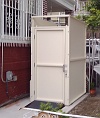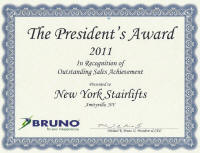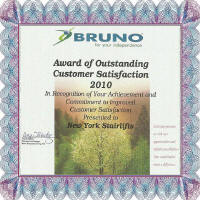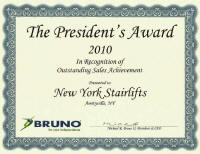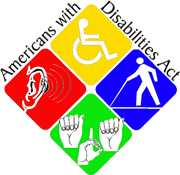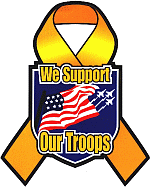"Common sense would seem to dictate that the installation or servicing of any equipment intended to transport
people should require the service of an experienced technician. This is especially true for the elderly and
disabled members of our communities."
- AEMA The Accessibility Equipment Manufacturers Association
![]()
What is a Stairlift?
General Stairlift Design Specs
Do I need a Stair Lift?
Questions for you
Additional Questions
What is a Stair Lift?
In simple terms, a stair lift is a motorized seat that travels up and down the stair case and is designed to
help people negotiate their stairs safely and with dignity.
A stair lift comprises a rail, which is permanently fixed to one side of the staircase (not the wall), a
drive-unit (sometimes called a carriage), which contains the motor, gearbox and controller - and the seat
assembly, which is attached to the drive unit.
Modern stair lifts are battery powered. That is to say that they operate independently from your household
electrical supply. If you have an outage, your stair lift will still operate normally until power is restored.
The batteries are charged by a device that simply plugs into a wall outlet, rather like a cell-phone charger.
General Stairlift Design Specs
Controls
The stair lift is controlled by an armrest mounted toggle switch. Two infra-red remote control handsets are also
supplied with your stair lift. These are very useful if there is more than one stair lift user in the household.
Safety
As you should expect, the stair lift is protected by a significant array of safety features to protect the user,
other members of the family and the equipment itself. The stair lift will stop immediately if the drive unit or
its' footrest come into contact with any obstruction on or near the stairway. Additionally we provide, as
standard equipment, a safety device called an over-speed governor (OSG). This essential safety feature will
prevent an uncontrolled descent of the stair lift, if a major drive-unit failure occurred. We strongly advise
you to disregard any stair lift that does not have this device included.
The Drive System
Our stair lift utilizes a direct-drive rack and pinion drive system. The motor and gearbox turns a toothed gear
(pinion) which climbs and descends a toothed flat gear (rack) which is installed in the rail. This type of drive
system has replaced the more old-fashioned chain or cable driven systems and is much quieter, smoother and more
reassuring than the older drive systems. The best feature of rack & pinion drives is that they are
maintenance-free, require no lubrication and are extremely durable. Cable and chain drives require periodic
re-tensioning and must be lubricated with grease that attracts dirt, dander and fluff.
Comfort and Convenience
Your stair lift should have a whisper-quiet, smooth glide, with a soft start and a soft stop. Jarring starts and
stops are not just uncomfortable, they are potentially dangerous. Our stair lifts feature electronically
controlled soft start and stop and utilize 12 precision guide rollers on the drive unit, to ensure the
smoothest, quietest glide available (most competitors use 6 or 8 rollers). We also have an oversized footrest
that is a mere 2¾" inches from the floor when the lift is parked at the foot of the stairs and is level with the
landing at the top. This is a very important consideration. With some stair lifts, the footrest is up to 8"
above the floor, which means the user has to step-up onto the lift. Again, this can be both uncomfortable and
potentially hazardous.
The stair lift seat turns at the top of the stairs and locks at 45 and 90 degrees. This makes getting on and off
the lift at the top much easier and safer. Naturally the lift will not operate while the seat is in the turned
position. Every stair lift is also equipped with a seat belt for safety and reassurance. The seat is also height
adjustable, to ensure a perfect fit.
Do I need a Stair Lift?
This is a very common question. for example, if you use a wheelchair, an inclined platform lift may be
much more suitable for you than a stairlift. It is important to discuss with us exactly what your
difficulty is, so we can be practical about the solution that provides you with the most ease and comfort.
It is also prudent to assess your alternatives. Some folks resign themselves to leaving the home they love and
moving to single story accommodation - this is a pretty drastic option and more often than not, a stair lift
will allow you to remain in your home.
Lots of people reluctantly live on the ground floor of their home - the upstairs being inaccessible to them. A
stair lift can give you back the freedom to enjoy your home to the full.
Of course, some people just 'tough-it-out', negotiating the stairs on hands and knees. The dangers here are
worryingly obvious and the thought of loved ones putting themselves in harms way like this is quite upsetting.
Again, a stair lift can create a safe, reassuring home life and restoration of dignity.
Questions for you to answer:
What type of stair lift am I looking for? Is the staircase a straight, L-shaped, U-shaped or curved staircases?
Is the lift for you or someone else?
Is there a door at the top or bottom of the stairs?
Indoor or outdoor?
Left or Right (viewed from bottom)?
Sit-down or standing/perching?
How many steps (the part you walk on) not including lower floor and top landing?
We are here to serve you:
Any other questions? We are happy to answer them. Call us toll-free today at 888.842.1065 or contact us
here for more information


